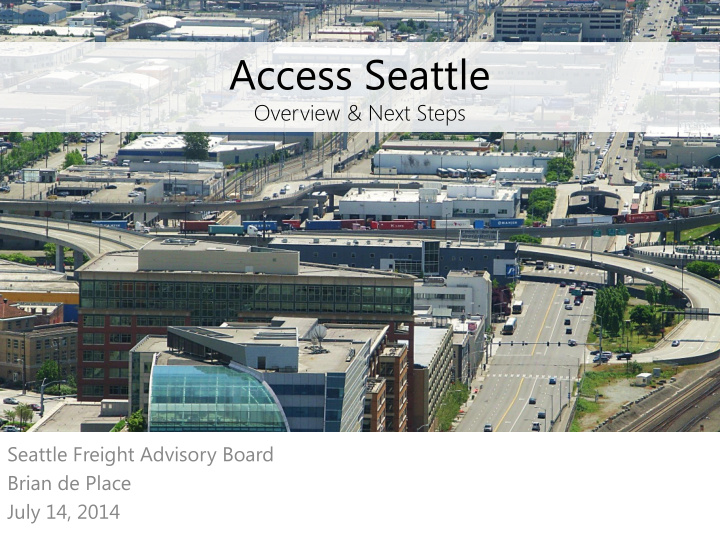



Access Seattle Overview & Next Steps Seattle Freight Advisory Board Brian de Place July 14, 2014
SDOT’s mission & vision Mission: delivering a first-rate transportation system for Seattle. Vision: a vibrant Seattle with connected people, places, and products. 2
SDOT’s core principles Keep it safe Provide great Focus on the service basics Support a Build healthy thriving communities economy 3
Presentation overview • Setting the context • Proposed framework • Three Pillars: 1. Construction Coordination 2. Traveler engagement 3. Business and community support • Questions & discussion 4
Context • Unprecedented growth and development • Progressive policies yield strong housing and job growth in Center City • Neighborhoods outside of Center City are growing and want to remain vibrant and thriving Source: Downtown Seattle Association 5
Three pillars of Access Seattle Construction Coordination Business and Traveler Community Engagement Support 6
1. Construction coordination Miss ssio ion: n: Coordinate construction and all activity that impacts right-of-way Traveller Maps mobility T arget et Audience: ience: Everyone performing work or having events that affect the right of way Pote tential ntial St Strategy tegy: : Establish formal Command Center to centralize and improve and Mitigation coordination functions 7
Construction hubs
Construction hub program objectives • Assess all project schedules together - identify conflicts and minimize mobility/access impacts • Create mapping systems showing all planned and active mobility impacts from all hub-area construction, in all phases • Establish reliable lines of communication with impacted communities • Provide on-site enforcement to monitor and resolve conflicts 9
Coordination tools
2. Traveler engagement Miss ssio ion: n: Engage travelers with real-time, actionable information on travel and transportation options T arget et Audience: ience: Traveling public Pote tential ntial St Strategy tegy: : Develop “One Stop” mobile app and other dynamic tools that provide information on construction activity, parking, and optimal modal choice 11
Levera eragin ging g opp pportunities nities: • Next Generation ITS, Traveler Map, Traffic Management Center Rebuild, e-Park and DMS programs • Seattle as T ech Incubator and OED-Supported Industry • Travel Options programs including Bike Share, Car2Go 12
Next t Generation neration Center ter City ty ITS S Increases ability to manage mobility for all modes during particularly heavy periods of construction. Examp mples les of system tem imp mprovement vements: s: • Real-time responsive signal timing • Adaptive signal control on key corridors feeding into Center City • Dynamic signs allowing SDOT to modify lane assignments and improve traffic flow 13
Examples of communications programs Traveler Information Map • available as smart phone app Sensors that provide • travel time information Dynamic signs showing • travel times on multiple routes e-Park expansion into • SODO and Seattle Center area Automated commercial • vehicle load zone occupancy information 14
3. Business and community support Miss ssio ion: n: Support business districts as thriving destinations by ensuring inviting experience and intuitive wayfinding Command Center T arget et Audience: ience: Business owners, residents, and visitors in construction hubs Pote tential ntial St Strategies tegies: • Designate SDOT Ombudsman for all construction-related issues, spanning across public and private projects • Develop “Construction Hub T oolkit” to Traveller Maps provide business assistance, signage and streetscape improvements, etc. 15
Maintaining Freight Access • Key corridors assessed: Haul Routes • Educating contractors • Enforcing & encouraging: - Site plans and traffic control plans showing all phases of construction, duration of each phase, and impacts to the ROW - Advanced warning signs for closures, clear detour signs identifying new routes - Coordination with other projects
Questions & discussion Brian.dePlace@seattle.gov Brian de Place | (206) 233-3855 http://www.seattle.gov/transportation/hub.htm http://www.seattle.gov/transportation
Recommend
More recommend